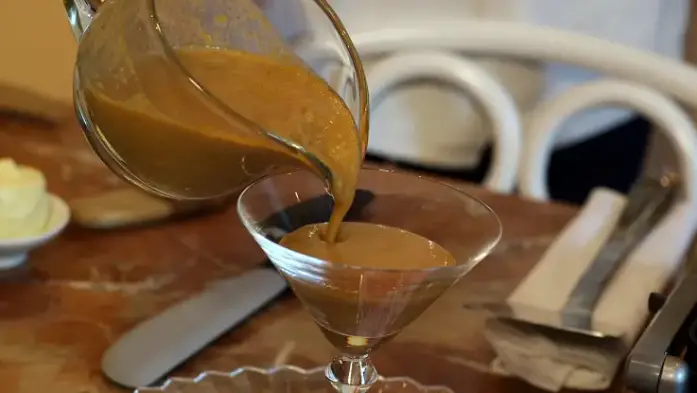|
Most wine lovers out there have probably had to endure the dreadful moment of opening up a bottle of wine, putting the cork back in to save the rest for later, and returning to it a few days later only to find that it has completely gone bad. This is not only frustrating for your taste buds as they were awaiting a rich glass of pinot noir or a crisp few ounces of chardonnay, but it can feel like a blow to your wallet, as wasting wine is never ideal. But in order to avoid this dreadful moment, we have to know how long wine can last after opening. When a bottle of wine remains unopened, it can last much longer than you may think. This is why you may have friends that have kept bottles around for 30+ years. "When you store a wine correctly, many wines can age for decades, and the easiest way to ensure proper storage is to purchase a wine fridge," says Natalie Tapken of Bluepoint Hospitality and recipient of three Wine Spectator Awards. "That's because heat is an enemy to wine, and ideally wine should be kept around 55 degrees for optimal storage. Anything above 70 degrees can 'cook' the wine and accelerate the aging process." Although wine can last for decades unopened, its lifespan drastically changes the moment the cork pops off and oxygen enters the scene. Read on to learn more from wine experts and sommeliers about how long wine lasts after opening, as well as a few tips on how to make it last longer once it's opened. Then, make sure to check out the Secret Side Effects of Drinking Wine. How long does wine last after it's opened? Once you open your bottle of wine, its propensity to stay fresh is more questionable than you might assume. "Oxygen is wine's enemy," says Dr. John McTavish, Ph.D. C.S.W, wine expert and sommelier. "The more time that wine is exposed to oxygen after the bottle is opened, the faster it will lose its fruity aromas and flavors and start to go bad." He adds, "Think of leaving a piece of freshly cut apple on your countertop. As it sits there exposed to oxygen, it starts to turn brown and oxidize." This oxidation effect is similar to what happens to wine once it's opened. Of course if you finish the bottle as soon as it's opened, you don't have to worry about how long it will last. However, this isn't always the case. If you opened a bottle and just enjoyed a glass (or two), and are now wondering how long the rest will stay fresh, the answer will depend on what type of wine it is, and how much is left in the bottle. After they're opened, "wines with sugar will last a bit longer," says Tapken. "For instance, a dessert wine can last a week, and a port can sometimes last two to three weeks." She adds, "A sparkling wine is best consumed the same, day but a great stopper can preserve a sparkling wine one to two days. A lighter white, with higher acidity levels, can last up to five days, and a typical white or red wine should be consumed in three days." Another thing to consider is how much wine you have leftover along with "how big or small is the oxygen to wine ratio left inside the bottle," says Dr. McTavish. "For example, if you serve one five-ounce glass of wine from a standard 25-ounce bottle and replace the cork, there will be more wine than oxygen in the bottle, which could last for five to seven days and still taste good. But, if you serve four five-ounce glasses of wine from a 25-ounce bottle, that only leaves five ounces of wine remaining in the bottle, and 20 ounces of oxygen, so the remaining wine may go bad much sooner." How to tell if your wine has gone bad Even though you have a baseline for knowing how long your favorite wine may last after opening, it might be helpful to know the telltale signs that the wine has gone bad. These signs also depend on what type of wine it is. "Once a sparkling wine bottle has been opened, it will start to lose its carbonation and flavor within a few hours. It's best to consume the entire bottle the same day it's opened," says Bash Hovian, owner of BASH the Bartender. "If you must store it, use a sparkling wine stopper to help preserve some of the bubbles, and look for signs such as a vinegar-like smell, a brownish color, or a sour/musty taste." On the other hand, when it comes to a still wine, "the presence of bubbles or fizz can also indicate that the wine has gone bad, so when in doubt, it's better to err on the side of caution and discard the wine if it smells or tastes off," says Hovian. When it comes to a red wine, "the signs include oxidation, loss of fruit characteristics, and softer tannins," says Sara Fowler, winemaker at Napa's PEJU Winery. "Simply put, it won't taste as good!" Tips for making your wine last longer once it's opened If you live on your own, don't drink a lot of wine, or are just trying to stick to one glass per night, you may be wondering how you can extend the life of your favorite bottle of wine.
Fowler suggests "placing opened wine in the fridge, storing in a smaller vessel, and sealing well." Tapken also adds that she "sometimes puts red in the refrigerator because you can get an extra day out of them. Just take the red wine out of the fridge an hour or so before drinking it to get the temperature you prefer." Source: Eat This, Not That!
0 Comments
When it comes to Guinness World Records, not all are created equal. Sometimes they’re handed out to people who are really large or dogs that are really small. Other times, recipients need to venture to outer space to qualify. But some Guinness World Records just require a lot of cheese, a lot of butter and a little bit of gold. Since 2014, New York City’s Serendipity3 has laid claim to the Guinness World Record for the world’s most expensive sandwich: a grilled cheese that costs a whopping $214. Orders for the high-priced “Quintessential Grilled Cheese” normally need to be placed 48 hours in advance, but this Wednesday Serendipity3 will be serving its record-holder all day. I stopped by Serendipity3 this week to try it out and see if there’s more to the sandwich than just the price tag. The sandwich is served on made-to-order French bread which is made with Dom Perignon champagne and has edible gold flakes baked into it. Each sandwich gets roughly a half pound of the rare caciocavallo podolico cheese, which retails for upwards of $50 per pound. That’s because there are only 25,000 cows whose milk is used to make this cheese, and they lactate for only two months a year. Is this level of decadence necessary? Not at all. Is it good? Absolutely. The bread is slathered with white truffle butter and brushed with white truffle oil — which has gold flakes mixed into it — before being grilled. “When we receive an inquiry we reach out to our sources right away and see if we can have these ingredients flown in,” Serendipity3 creative director Joe Calderone tells CNBC Make It. “We have our baker on board to bake the loaf, so we get the wheels in motion right away.” When the sandwich is ready to be served, it is cut diagonally and each half gets a layer of edible gold on its cross section. But it doesn’t end there. Instead of tomato soup, the sandwich is served with a South African lobster tomato bisque on the side for dipping. Let’s be real here: the price of this sandwich is more than I’ve spent on the ingredients for every grilled cheese I’ve eaten over the past 28 years of my life.
Is this level of decadence necessary? Not at all. Is it good? Absolutely. The gold leaf doesn’t add anything in terms of flavor, but it’s a fun, over-the-top novelty addition at a restaurant where everything from the menu to the décor is over-the-top. The bread is great too, but it’s the cheese itself that’s the star of the show. Caciocavallo podolico tastes like parmesan and manchego had a baby, but it melts like a munster. It instantly makes sense as the cheese of choice for the most expensive grilled cheese money can buy. But still, it’s a lot of money for a grilled cheese. Could I justify spending $214 for a food I could make at home for less than a tenth of the price? I don’t think any amount of gold leaf could get me to answer “yes” to that question. But for someone with plenty of disposable income who wants to try a one-of-a-kind sandwich, the Guinness World Record-holding grilled cheese is hard to beat. The perfect breakfastIndeed, a breakfast packed with carbohydrates encourages insulin secretion, which should be avoided — especially in the morning. Here are our recommendations for a delicious, healthy breakfast based on the advice of nutritionist Anthony Berthou. 1 – A protein source (ideally eggs) We tend to gravitate toward sweet breakfasts, but savory choices are more advisable. Eating animal protein in the morning promotes the production of dopamine, a neurotransmitter that stimulates the mind and jump-starts your motivation to tackle the day. In addition to making you more motivated and alert, consuming protein at breakfast can also help you feel full longer and reduce snacking later in the morning (see our article on proteins). Finally, because our breakfasts often include lots of carbohydrates, eating protein helps reduce the speed at which the carbohydrates are absorbed. Protein increases the time it takes to digest carbs and lowers their glycemic index. That means that it reduces insulin spikes and prevents the infamous pre-lunch slump. Eggs are the perfect solution because they contain extremely high quality protein and are rich in vitamins and minerals. But there are other protein sources you can try for variety:
Are eggs really bad for cholesterol? Contrary to what we often hear, the impact of eggs on cholesterol is quite limited: the majority of our cholesterol does not come from dietary cholesterol, but rather blood cholesterol, which the body produces from the foods we eat. Therefore, eating one or two eggs a day does not cause a significant rise in blood cholesterol and does not increase cardiovascular risk. Still, there is an important distinction in the case of diabetics, who should only eat three to four eggs per week. 2 – Healthy fat: almonds, walnuts and hazelnuts. Including fat with your breakfast is crucial, but you have to choose the right one! High-quality fatty acids, including omega-3 and omega-9, are indispensable to keeping the body running smoothly: they help prevent cardio-vascular disease and diabetes and play a role in brain, muscle and bone development (see our article on lipids). These “good fats” are found in nuts, such as almonds, walnuts and hazelnuts. Walnuts are the nut with the highest omega-3 content. In the morning, you can consume 1 to 1.5 ounces of mixed walnuts and almonds to get omega-3 fatty acids, fiber and magnesium. An alternative way to eat quality fat is to eat chia seeds, pumpkin seeds, avocado or fatty fish such as salmon or sardines. For your toast, you can forego the jam (which is full of sugar) and replace it with nut butter made from almonds, hazelnuts, cashews, peanuts. 3 – Real fruit (not fruit juice) Drinking fruit juice is not the same thing as eating fruit! Fruit juice does not contain any fiber. And fiber is what slows down the speed at which the sugar in fruit is digested. That explains why the glycemic index is higher for fruit juice than for fruit. For example, the glycemic index for an orange is about 35, whereas the glycemic index for orange juice is around 45. Furthermore, eating whole fruit encourages chewing and promotes satiety, which does not happen with fruit juice. Lastly, fruit juice contains fewer vitamins than the fruit itself. So, go for fruits rather than fruit juices — even homemade versions and guaranteed 100% pure juice! Is it absolutely essential to eat breakfast even if you aren’t hungry? If you are not hungry, don’t force it. Unlike what we are often told, it is absolutely possible to pass on breakfast. You can even omit your morning meal every day, provided that you eat a balanced diet for the rest of the day. That enables intermittent fasting. Because the body is always working on digestion, it is beneficial to give it some rest time. On the other hand, be careful not to compensate by snacking all morning. If you are hungry mid-morning, reach for a truly balanced snack comprised of fruit, a yogurt and a handful of nuts. 4 – Optional: quality carbohydrates Contrary to common wisdom, it is possible to have a breakfast without grains as long as the meal contains enough high-quality fat and protein. However, if you cannot do without them, be sure to choose the right carbs. After all, baguettes, sliced bread (white bread in general), puffed grain cereal and crispbread are a far cry from what we call “slow-release carbs”. These foods have a high glycemic index and encourage insulin secretion. That means you should turn to grain products with a low glycemic index, such as whole-wheat sourdough bread, mixed-grain organic bread or traditional muesli (an oat- or spelt-based blend). 5 – Green tea Hydrating the body is crucial. Green tea is the best option at breakfast. It is packed with antioxidants, which are beneficial in the prevention of many illnesses, such as cancer and degenerative diseases. Ideally, you should steep it at 185°F for a few minutes to extract all the antioxidants. Green tea also has caffeine that gives the brain a boost by improving attention span and memory. Coffee is also a good bet for breakfast because of its antioxidants, but it should be consumed in moderation. Sources:
A recent comprehensive study led by researchers at Harvard T.H. Chan School of Public Health suggests that eating as little as two servings of red meat per week could significantly increase the risk of developing type 2 diabetes. The study, published October 19, 2023, in The American Journal of Clinical Nutrition, carries crucial implications regarding your dietary choices, revealing that your diabetes risk might increase with the more red meat you eat. However, the researchers point out that substituting red meat with healthy plant-based proteins, such as nuts or legumes, or moderate amounts of dairy products, may help reduce the risk of developing type 2 diabetes. Keep reading to learn more about the study’s findings and what they mean for your health.
What the Study Found To arrive at these conclusions, researchers with the Harvard T.H. Chan School of Public Health analyzed a substantial number of type 2 diabetes cases over an extended time period to draw connections between red meat consumption and disease risk. They extracted data from a vast pool of 216,695 participants in studies such as the Nurses' Health Study, NHS II and Health Professionals Follow-Up Study. The participants’ dietary habits were assessed through food frequency questionnaires every two to four years for up to 36 years. During this time, more than 22,000 participants developed type 2 diabetes. The researchers found that consuming both processed and unprocessed red meat significantly was correlated with an increased risk of developing type 2 diabetes. Those who consumed the highest amounts of red meat faced a 62% higher risk than those with the lowest intake. Substituting red meat with plant-based protein sources like nuts and legumes was associated with a 30% lower risk, while replacing red meat with dairy products lowered the risk by 22%. If you’re curious as to how much red meat is safe to eat, senior author Walter Willett, M.D., a professor of epidemiology and nutrition at Harvard T.H. Chan School of Public Health, said in a statement, “Given our findings and previous work by others, a limit of about one serving per week of red meat would be reasonable for people wishing to optimize their health and well-being.” The implications of this research go beyond personal health, as reducing red meat consumption in favor of plant-based protein sources may offer environmental benefits by helping to lower greenhouse gas emissions related to food production and helping combat climate change. The study reinforces the idea that limiting your red meat intake to one serving per week may be a smart option for those looking to optimize both their personal health and the well-being of the planet. The Bottom Line A recent study led by researchers from Harvard T.H. Chan School of Public Health suggests that eating as little as two servings of red meat per week could significantly increase your risk of developing type 2 diabetes. The study reveals a direct correlation between red meat consumption and diabetes risk, emphasizing that the more red meat you consume, the higher your risk becomes. However, the researchers indicate that substituting red meat with healthy plant-based proteins, such as nuts or legumes, or moderate amounts of dairy products, may help reduce the risk of developing type 2 diabetes. More research is needed to help clarify these findings in a broader population, but they’re promising for those looking to lower their risk of this common chronic disease. This research also reinforces that limiting red meat intake to about one serving per week may be a helpful strategy for improving personal and planetary health. Source: EatingWell.com |
|
Bergen Review Media is a
WebClientReach, llc Company |
50 East Ridgewood Ave. #215
Ridgewood, NJ 07050 Phone: (201) 948-5500 |
The Bergen Review is Bergen county's concierge for the best businesses, restaurants & venues in New Jersey. Our agency has a combined total of over 15 years experience in online media and marketing. Our team of experts scour every nook and cranny of New Jerseys best businesses, restaurants & venues to present to our clients the full scoop of where best deals & experiences are. Even after researching & looking at reviews, finding the REAL scoop on what Businesses, restaurants or venues best fit your interest can be a challenge. Bergen Review Media has a team that researches & visits various establishments. Making sure the consumer gets the best experience.
|
Website by Bergen Review Media

















